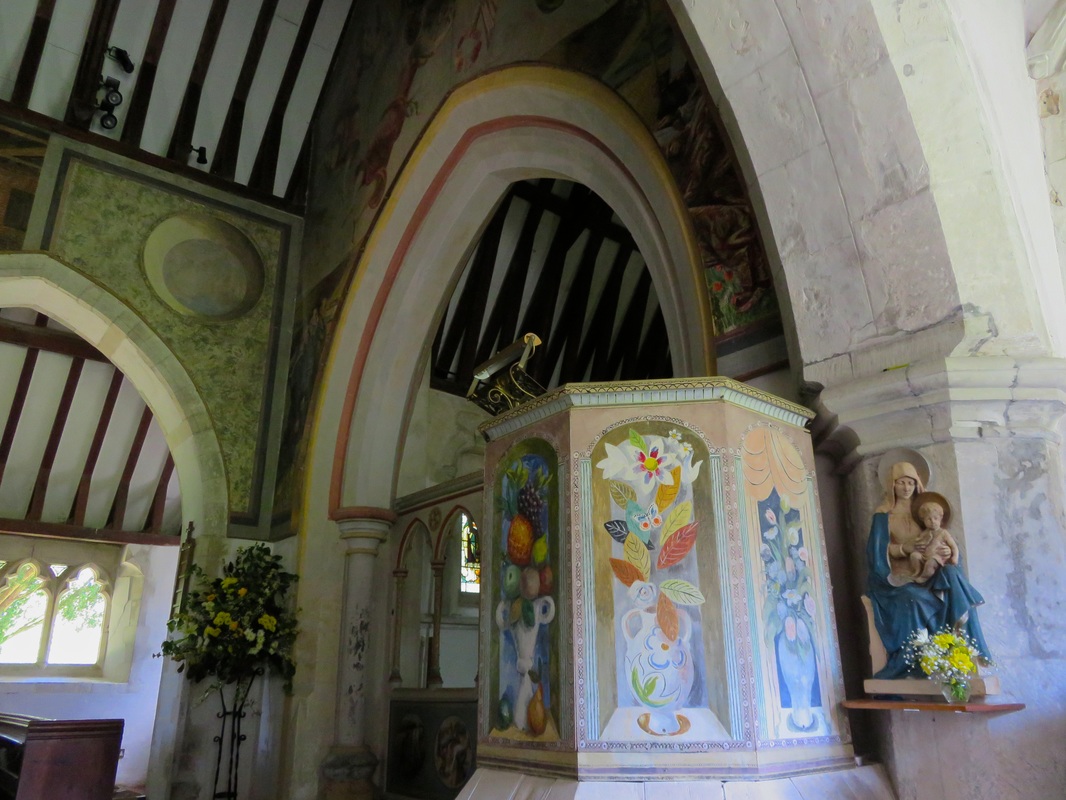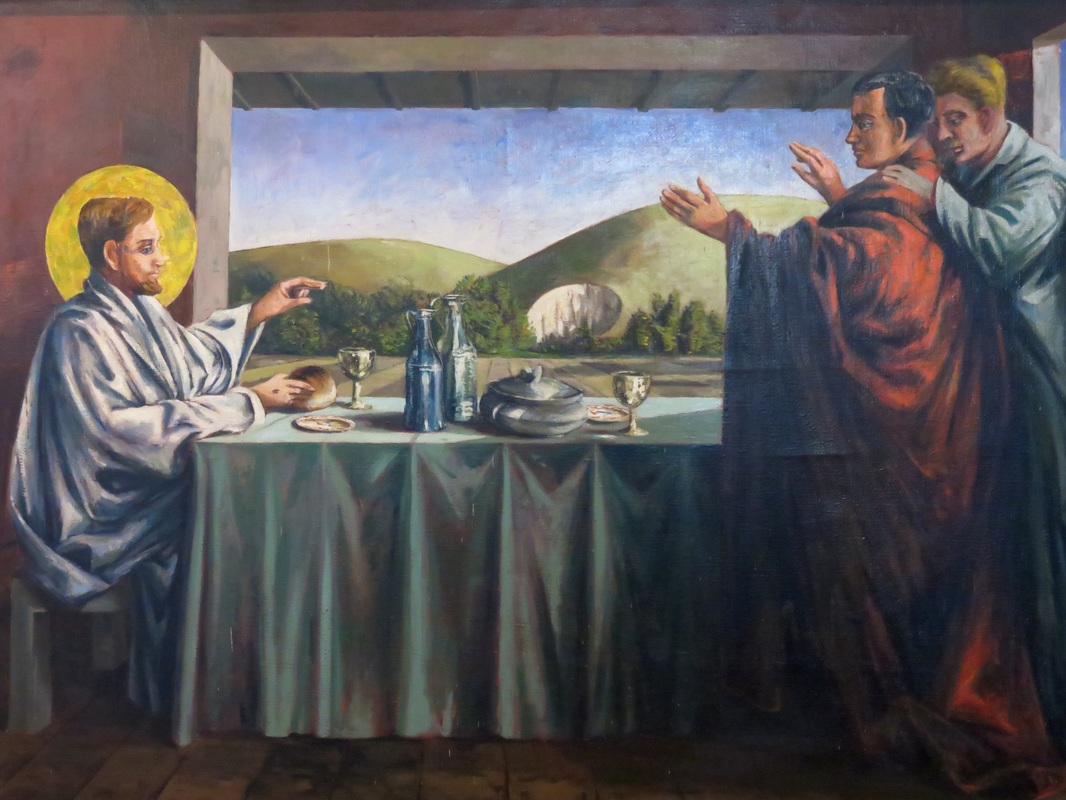| We live on the site of the Battle of Hastings (probably quite literally), our house is over 400 years old, our neighbour’s house has a 12th Century cellar and well, Battle Abbey is two minutes walk up the street - it’s impossible get out of bed without bumping into a place of historic interest! But in the end, we found something further afield . . . (By the way, this post has a lengthy, meandering introduction. It’s a bit like those food blogs where you have to read through a three thousand word essay before you get to the recipe!) Mapless ramblingI’ve been on a new kick this month: day-long, mapless walks. My partner is working in Brighton, so I jump in the car with him in the morning, get him to drop me off somewhere, then start walking. He picks me up from wherever I happen to be on his way back from work. It’s been wonderful. I set out with very little: a camera, a bottle of water, sunscreen, a notebook, my phone, a few things in my pockets (bank card, paw paw ointment and tissues) and perhaps a vague sense of where I might like to walk. The latter usually goes out the window - I’ll find an interesting looking footpath and go that way instead, or head towards a distant landmark, or I’ll just . . . get lost. Getting voluntarily lost is a new experience for me. I’m map-obsessed and when I’m out walking with a map I’m confident I’m either on the right track, or how to get (back) on the right track. Walking in moderately unfamiliar territory without a map means relying on signposts and waymarkers along the rights of way. Sometimes the waymarkers have faded to nothing. Sometimes the signposts are broken. Somethimes there's no marker at all. I’ve ending up wandering around fields of waist-high grass looking for exit points (so many grass seeds in my boots), jumping over a fence to escape a jostling herd of merely curious but nonetheless potentially dangerous steers, walking giant loops around farms because the paths seem to go in circles, going on epic diversions to find lunch, worrying about being cut off by rivers and wishing that a landowner would come to tell me I’m trespassing so they could put me back on a proper path! That makes it sound stressful, but for the most part it’s just the opposite. Walking those big loops or having to backtrack doesn’t matter when you don’t have a destination: there’s never a “wrong way” to go. And every time I’ve been lost I’ve ended up finding an onward right of way. I quite like feeling the sweet wash of relief when I sight a proper finger post, or a circular yellow waymarker, or a sign showing a permissive path, or perhaps just a piece of yellow tape on a gate or post. Being destination-less also means finding places I would otherwise never go, because they’re not on the way to anywhere else: tiny streams; huge, shady chestnut trees; secluded fields where I might chance upon a flock of deer; beautiful houses with landscaped grounds; pastoral views and sweeping vistas; secret dens; pretty hamlets with summer gardens in full bloom; interesting churches… Out on one of these mapless rambles this week, I found myself at Berwick Village Store buying a freshly made sandwich for lunch. The friendly people there suggested I visit Berwick Church. Berwick is in two parts: the newer village around the station and the older village, a mile or so down the road and across the highway, around the church. So I wandered off with sandwich in hand and, after scoffing my lunch (delicious) in the church yard, I went in to have a brief look. When my partner picked me up a few hours and several miles later, I suggested we head back to have a proper poke around. We figured this ticked the boxes for our monthly microadventure theme, too! Berwick church - St Michael and All AngelsFrom the car park (no parking on Sundays, congregation only) a handpainted sign points to the church - up a curving, walled footpath, lined with multicoloured hollyhocks, purple mallow and other pretty flowers. You enter the churchyard through an arched gate and climb the path to the church itself. The first unusual thing you might notice is that the windows are single panes of glass, so you can see into the church and right through to the other side. The windows were damaged by bombing in WWII and replaced with plate glass because many people considered it likely the area would be bombed again. Once inside, the most obviously remarkable thing about the church is revealed: the walls and various panels are covered in paintings - not relics of ancient artwork, but relatively modern pieces. Apparently, in the 1940s, the Bishop of the area decided to experiment with bringing back the older tradition of murals inside churches, and Berwick was considered “a suitable case for an experiment because to all intents and purposes it is a modern church.” Duncan Grant was the chief artist, while Vanessa Bell and Quentin Bell also contributed. The trio’s main claim to fame for many people will be that Vanessa was Virginia Woolf’s sister. Duncan and Vanessa moved to Charleston Farmhouse, a few miles away from the church along the foot of the Downs, which became the country house of the Bloomsbury Group. (We've never been to Charleston - an outing for another time!) The paintings contain an odd mishmash of people (the holy family and other figures were modelled by the Bloomsbury set and local residents), styles (there were three painters at work, after all) and clothes (period costume, traditional swirling robes, 20th Century military uniforms). But the scenes are held together by the constant presence of the South Downs and the fruits of this landscape: Firle Beacon shares centre stage with the holy family in “The Nativity”; a stylised chalk pit echoes the circle of Jesus’ halo in “The Supper at Emmaus”; the instantly recognisable downland slopes mark the division between earth and heaven in “Christ in Glory”. If you glance out of the clear south aisle windows, you may glimpse the same hills through the trees that border the church yard. Once you tear yourself away from the colourful paintings, there are other interesting things to notice. Not least is a squat Saxon font that huddles into the wall at the back of the church - the wall is 12th Century, but the font is older still. The marks in the stone nearby are thought to have been made by people sharpening arrows on the wall during the 14th Century, when archery practice was made compulsory on Sunday after church. Back outside, you can stroll around the churchyard, stopping to admire a sculptural bird bath by Sarah Walton or stepping out through the back gate to the old chalk coach road that skirts the foot of the South Downs. The slopes rise steeply beyond fields of corn, wheat and barley. Earlier in the day I was up on Firle Beacon, admiring the view of the sea to the south and the beautiful, sweeping vista across the Levels, the chequered fields, the swelling rise of the Downs to the west, and the wooded line of the High Weald marking the northern horizon. I could trace where I’d walked during my mapless rambles: back to Berwick, to Arlington Reservoir, the spire of Arlington Church, the tiled roofs of Hailsham and Horsebridge - and then, further away, the dome of the big observatory at Herstmonceux and a white speck that might be the windmill at Windmill Hill. Somewhere even more distant, tucked away in the hills, is Battle - with its significant history and our little house. |
|
June’s microadventure challenge was to visit a place of historic interest. We are spoilt for choice here, which made it all the more difficult to settle on a destination! I'll be posting the July microadventure round-up soon, but if you're a keen bean you can peek through my archives and read about other microadventures and other walks!
10 Comments
Mags
3/7/2015 13:14:42
Wonderful report Jonathan. I absolutely love the church at Berwick. Have you been to Charleston yet?
Reply
It's easy to forget sometimes in winter, when the days are short and we're commuting in the dark, that there are so many places to visit and things to see. It's starting to get lighter in the mornings and evenings again now, and these summer posts make me excited for the changing seasons!
Reply
27/12/2017 04:08:21
Great idea, I can't imagine a walk without checking a map at some point. I love the idea of just picking a path and following it, I might try it in the summer some time :)
Reply
It's a really interesting experience and it does make you think about journeying in a different way. I think summer is the ideal time for it, because you don't have to carry so much and you're less likely to end up in a rain storm! Do let us know if you try it out! :)
Reply
Your comment will be posted after it is approved.
Leave a Reply. |
In which IIn which I do things and write about them In which I tag
All
In which I archive
July 2022
|














 RSS Feed
RSS Feed
